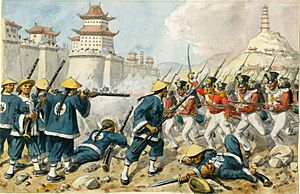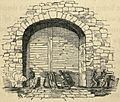Battle of Chinkiang facts for kids
Quick facts for kids Battle of Chinkiang |
|||||||
|---|---|---|---|---|---|---|---|
| Part of the First Opium War | |||||||
 British troops taking Chinkiang from Qing troops |
|||||||
|
|||||||
| Belligerents | |||||||
| Commanders and leaders | |||||||
| Hugh Gough | Hai Ling † | ||||||
| Strength | |||||||
| 6,907 troops | 3,000–4,000 troops (est.) | ||||||
| Casualties and losses | |||||||
Land:
|
1,000 killed or wounded | ||||||
The Battle of Chinkiang (Chinese: 鎮江之戰) was a big fight between British and Chinese forces. It happened in Chinkiang (Zhenjiang), China, on July 21, 1842. This battle was part of the First Opium War and was the last major fight of the war.
The Chinese army defending Chinkiang was made up of soldiers called Bannermen. These were special Manchu and Mongol troops. The British forces were led by Sir Hugh Gough. Another important British leader was Sir Colin Campbell.
Chinkiang was a very important city. It was located where the Grand Canal met the Yangtze River. The Grand Canal was like a huge highway for moving food, especially grain, all across China. When the British took Chinkiang, they blocked this important transport system. This made it very hard for the Chinese government to get food to its people.
Because of this, the Daoguang Emperor of China decided to stop fighting. He agreed to sign the Treaty of Nanking. This treaty officially ended the war.
Contents
Why Chinkiang Was Important
Chinkiang was a key city because of its location. It sat right at the meeting point of two major waterways. These were the Grand Canal and the Yangtze River.
The Grand Canal's Role
The Grand Canal was a vital part of China's transport system. It was used to move grain and other goods across the empire. Blocking this canal meant that food could not reach many parts of China. This put a lot of pressure on the Chinese government.
The Battle Begins
In mid-July 1842, British ships gathered near Chinkiang. They blocked the water route between the Yangtze River and the Grand Canal. This was a smart move to cut off supplies.
On the morning of July 21, the British launched their attack. They attacked Chinkiang from three different directions. They used four groups of soldiers, called brigades.
Attacking from Three Sides
- The first brigade had 2,310 soldiers. They attacked the Chinese army outside the city. They had help from powerful artillery.
- The second brigade had 1,832 soldiers. They attacked the west gate of the city. The British navy supported them from the water.
- The third brigade had 2,155 soldiers. They attacked the north gate.
At this time, Chinkiang was defended by about 1,583 Bannermen. There were also 2,700 Green Standard Army troops. These Green Standard Army soldiers had just arrived from other areas. They were not familiar with the city's layout. Most of their weapons were swords and spears, with only a few muskets.
Fierce Fighting at the Gates
The battle started early in the morning.
North Gate Attack
At 7 a.m., the British third brigade landed at Beigu mountain. They attacked the north gate. British warships fired heavy artillery to cover their advance. The Bannermen defending the north gate fired back with muskets. They even quickly set up their own artillery. After a tough fight, the Bannermen's artillery was destroyed. British troops then rushed the city wall.
Green Standard Army Defeated
Before sunrise, the British first brigade landed successfully. They took control of high ground near Jinshan. At 8 a.m., they attacked the Green Standard Army outside the city. These Chinese soldiers were tired from their long journey. They also didn't have enough food. After a fierce battle, they were defeated. Their commander saw fires inside Chinkiang. He thought the city was lost and ordered his remaining soldiers to retreat. Many soldiers left the army.
West Gate Breakthrough
The west gate was a main target for the British. Soon after the fighting at the north gate began, the British second brigade attacked the west gate. British soldiers took over houses outside the city. From there, they could shoot at the defenders.
A British ship with marines sailed along the canal towards the west gate. They planned to attack the city from the water. The Chinese defenders at the west gate fired at both the land troops and the marines. They injured many British sailors and officers. This forced the British to pull back from the canal.
After this, the British sent 200 more marines to help. They attacked Chinkiang again. They managed to take some city buildings. There was fierce street fighting inside the city. Around noon, British engineers used gunpowder to blow up the west gate. At the same time, the British third brigade, which had taken the north gate, rushed to the west gate. Finally, the Chinese defenses were broken. Many British soldiers and officers were injured or killed in the street fighting.
Images for kids







